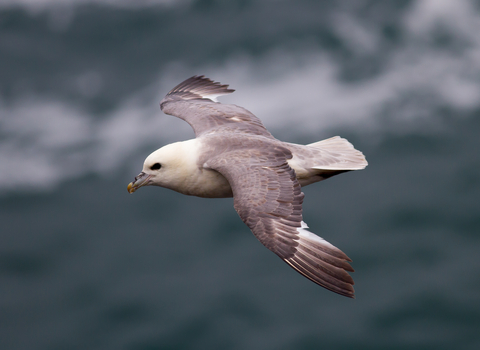
©Mike Snelle
Fulmar
Scientific name
Fulmarus glacialisWhen to see
January to DecemberSpecies information
About
Fulmars are members of a group of birds known as 'tubenoses', or 'petrels', which includes both giant albatrosses and tiny storm petrels. In the 1800s, fulmars only nested in one or two places on islands in the far north of Scotland. Since then, they have expanded their range and can be found around the UK's coast, nesting in colonies on cliffs or flocking to feed out at sea.How to identify
The fulmar looks similar to a gull, but with straighter, stiffer wings and a thickset neck. It has a white head and underside, grey wings and grey-yellow beak.Distribution
Nests around the coasts of the UK.In our area
The Isles of Scilly are home to breeding populations of thirteen species, including fulmars, with around 20,000 birds in all. The best time to enjoy them is the spring and summer, from April to July, when you'll see the biggest diversity. Kittiwakes loiter around the islands, whilst fulmars hang on the wind off their cliffs. Shags stand sentry on the rocks, puffins, guillemots and razorbills hang out on their islands, whilst flocks of gannets (which don’t breed on Scilly) feast on the small fish that are shoaling around the islands. Gulls swoop around the harbour and bays and shout out their noisy calls over Hugh Town.
Did you know?
If threatened, nesting fulmars will spit a foul-smelling oily mixture on to intruders. In the 1900s, this oil was considered valuable for its medicinal properties, so fulmars were harvested by the inhabitants of the islands they visited.The Isles of Scilly are home to breeding populations of thirteen species, including fulmars, with around 20,000 birds in all. The best time to enjoy them is the spring and summer, from April to July, when you'll see the biggest diversity. Kittiwakes loiter around the islands, whilst fulmars hang on the wind off their cliffs. Shags stand sentry on the rocks, puffins, guillemots and razorbills hang out on their islands, whilst flocks of gannets (which don’t breed on Scilly) feast on the small fish that are shoaling around the islands. Gulls swoop around the harbour and bays and shout out their noisy calls over Hugh Town.
